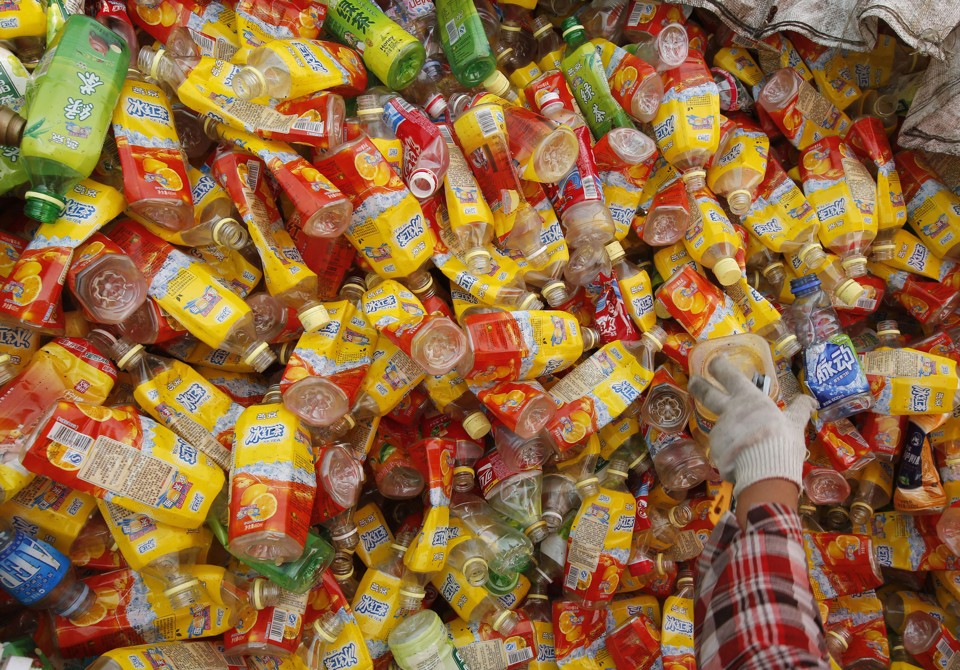Which is not particularly hard to imagine, given the ubiquity of plastics. Now, for the first time, researchers have published a sweeping, public, and in-depth accounting of all plastic that has ever been made in the entire world. The number is so big as to defy human comprehension: 8,300 million metric tons since 1950. Of this, 6,400 million metric tons has outlived its usefulness and become waste; 79 percent of that waste is sitting in landfills or the natural environment, 12 percent has been incinerated, and just 9 percent has been recycled.
Donald Loepp, editor of the industry paper Plastics News, called the study an “impressive report.” It’s something that many people have speculated about, he says, but no one had published such a thorough accounting until now.
Perhaps the most eye-popping statistic in the study is how quickly plastic production has been accelerating in just this millennium. The world has made as much plastic in the past 13 years it did in the previous half-century. “I think [that’s] the number that captures it best,” says Roland Geyer, an industrial ecologist at the University of California, Santa Barbara and an author on the study. We’re still rushing headlong into the plastic age.
Geyer and his team rely on both publicly available information and industry reports that they purchased for the study. They begin their analysis in the year 1950, when plastic started entering civilian life. During World War II, the military was starting to find uses for plastic. “The way the war disrupted trade, for example, with natural rubber supplies from southeast Asia or the silk supply out of Japan, affects how tires are made, how parachutes are made, and tread for boots,” says Rebecca Altman, a writer and environmental historian. “The stage was set for plastics to really take off after the war.”
It’s worth considering how much the rise of plastic is tied to the rise of oil and gas. Around this time, the United States began using a lot more oil. Oil is easy to make into plastic, and and it is cheap to do so. These economic forces helped create a new category of product: the disposable, single-use plastic packaging.
Packaging is now the largest plastic market, and it’s still tied to fossil fuels. In June, The Wall Street Journal reported on how the United States’ natural gas boom was translating into cheaper plastic pellets. The Dow Chemical Company wants to send its plastic pellet to places like Brazil, where it’s betting that a rising middle class will want the convenience of single-use plastic baby-food containers. Developing countries in South America and Asia account for much of the recent growth in plastics consumption.
These economic forces also govern how plastic gets recycled—or doesn’t. It’s often cheaper just to make virgin plastics, especially if you need plastic of a certain hardness or durability. Plus, there are so many different types of plastics that need to be sorted. “Plastic recycling just suffers from poor economics,” says Geyer.
It wasn’t always obvious that petroleum-based plastics would dominate. In the early 20th century, scientists experimented with plastics made from plant-derived carbon-based molecules. Henry Ford unveiled the “soybean car” in 1941. The car had a hard plastic shell, made of soybean fiber. The field of chemurgy—dedicated to turning agricultural materials into industrial products—rose and quickly fell, thanks to the ascendance of petroleum. It’s come full circle in a way. Now there are bioplastics, made out of biological
I asked Geyer if he thought we would eventually move beyond petroleum-based plastics, given a long-term move away from fossil fuels. “Unfortunately, my answer will be no,” he said. He gave two reasons. First, plastic production uses only a tiny fraction of the fossil fuel that we currently use for energy, so there will be plenty to go around for a long time. And second, he’s not convinced that bioplastics have less of an environmental impact. They aren’t necessarily more biodegradable, and they divert crops away from food. Since large-scale agriculture also relies on fossil fuels for fertilizer, there’s no way to go completely fossil fuel-free yet.
So our plastic age goes on. We will keep adding plastiglomerate to the geological record of the Anthropocene.

 In 2014, scientists found
In 2014, scientists found